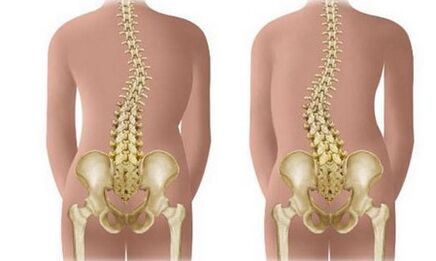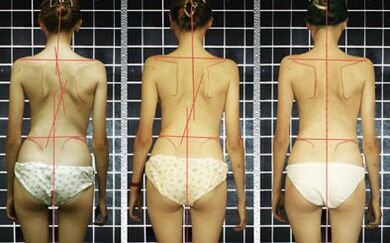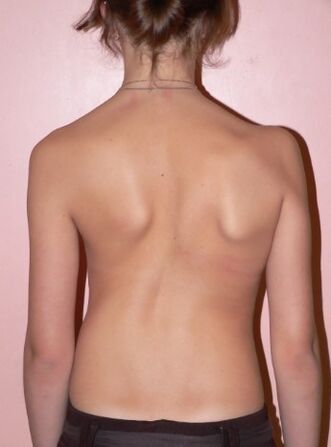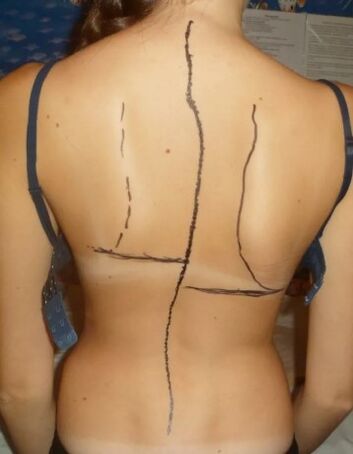In Greek there is the word "scolios" that is translated as "crooked".In this word, the doctors denote the curvature of the spine.Furthermore, not all curvature, namely the lateral deviation of the vertical axis of the spine.The fact is that our spine is usually not perfectly smooth.The available bends in front and rear (Lordoses and kyphosis) protect our spine from excessive load while maintaining the body in a particular position as you move and carry weights.Negative processes in our body develop only in cases where these kyphosis and lordoses are expressed beyond the permissible norm.

The biggest problems
However, even a small degree of lateral bends (scoliosis) of the spine is always a pathology.And the point is not only in a cosmetic defect.Although a distinctive repulsive appearance with pronounced or progressive scoliosis is always a tragedy for a person seeking to live a full quality in full life.This is especially true for young boys and girls.In fact, it is during the children's and the youth period (up to 15 - 16 years) that a significant part of scoliosis is diagnosed.
The main problem is that due to a change in configuration and volume of the chest with pronounced lateral curvature, internal organs always suffer (heart, lungs, stomach, liver, intestine, large vessels).In men, tolerance of physical exertion decreases, women have problems with conception, carry pregnancy and births.In addition, very often the lateral deformation of the spine is just the surface part of the iceberg, which is a sign of a much more severe pathology - tumor, tuberculosis, endocrine disorders.
Causes
So why is the spine deformed?Before answering the question, you must decide that the types of scoliosis.At its core, scoliosis can be structural and unstructured.Structural scoliosis develops due to anatomical changes in the structure of the bone tissue in the vertebrae as well as muscles, nerves and ligamentous appliances located nearby.Such curvature can be acquired and congenital, and about a quarter of all diagnosed scoliosis signs for the latter.
Among the main causes of the development of structural scoliosis they distinguish:

- Master of intrauterine development leading to dysplastic disorders in one or more vertebrae
- Congenital breast development abnormalities - lack of ribs, additional ribs
- Congenital pathology of connective tissue - neurofibromatosis, marfan -syndrome
- Brain defects due to children's cerebral paralysis (cerebral palsy), leading to a violation of innerving of certain parts of the spine
- Osteoporosis (bones -tissue) of the spine in rocket, diseases of the parathyroid glands, a lack of calcium intake with food
- Osteomyelitis of the vertebrae
- Dystrophic changes in cervical, thorax muscles
- Tuberculosis damage to the vertebrae
- Spinal cord injuries
- Tumors in the spine.
Non -structural scoliosis, which follows from the name itself, is the lateral deviations of the axis of the spine with the unchanged structure of the vertebrae.As a rule, such scoliosis is most often acquired with the exception of cases where curvature is compensatory in nature with congenital anatomical defects in the pelvis or lower extremities.The causes of such scoliosis are most often:
- Bekkenskades and lower extremities
- Congenital defects in the pelvis and lower extremities
- Constantly wrong attitude of schoolchildren
- Diseases of internal organs with asymmetrically expressed pain syndrome
- Muscle inflammation (myosites)
- Burns, scars of soft fabrics on one side.
In these cases, to eliminate the curvature of the spine, it is enough to cure the underlying disease, and therefore many unstructured scoliosis is slightly reversible.In this regard, some doctors tend not to count on unstructured deformations for scoliosis in general.

Recently, cases of development of scoliosis with unclear reasons have become more frequent.This is the so -called idiopathic scoliosis.It occurs in adolescence during the period of rapid growth in the body.Furthermore, girls suffer from idiopathic scoliosis several times more often than young men.Apparently this is due to the relatively weak muscles on the back of the woman, which is unable to enclose the spine in a full muscle frame.An unbalanced diet with low calcium salts and a general passion for young people with carbonated drinks does not play the last role in the development of idiopathic scoliosis.As you know, carbon dioxide contributes in bubbles and orthophosphane acid in synthetic inclusions for leaching of calcium salts from the body.
Sort and degrees
Depending on the location, scoliosis may be cervical, chest, lumbar or mixed (cervical, lumbosacral).It is possible to have one or more curvature bows.In this regard, C-shaped scoliosis (with 1 bow), S-shaped (with 2 bows) and z-shaped (with 3 bows) is separated.Most likely, the presence of 2 or 3 arches is compensatory.With C-shaped scoliosis, the spine differs.In an attempt to compensate for this, the spine is bent in the opposite direction.In this regard, scoliosis is divided into compensated and uncompensated.In compensated spinal curvature, a vertical line is lowered from the 7th cervical vertebra through the fold between the buttocks.
The curvature of the spine is often combined.For example, in the thorax region, pathological kyphosis is noticed beyond lateral curvature or just a hump.In these cases, talk about thoraxkyphoscoliosis.In addition, Thuria is noted with large degrees of scoliosis beyond the lateral displacement of the vertebrae.In a literal translation it means twisting.In fact, with many scoliosis, vertebral bone tissue is twisted along the vertical axis.
Depending on the size of the angle of the curvature of the curvature, 4 degrees are separated by scoliosis:
- 1 degree- The angle of curvature does not exceed 10 degrees.Asymmetry at the eye is practically not determined.Stoopen, the odd level of the shoulder band, notices.
- 2 degree- The angle of curvature is from 11 to 25 degrees.To this extent, the vertebrae are already noticed.There is an asymmetry of the shoulder band and the pelvis that is visible on the eye.Due to the pathological muscle tension, a muscle roll is formed in the lumbar area from the concave side and in the breast area-with a convex.
- 3 degrees- Wrtification is from 26 to 50 degrees.Visible deformation of the breast - the western of intercostal space C in the concave side of curvature and swelling with convex.Weakening of the abdominal press, the formation of an internal hump.
- 4 degrees- The angle of curvature I exceed 50 degrees.A cosmetic defect and all previous signs are expressed.Low tolerability of even little physical exertion.In addition to the musculoskeletal system, internal organs suffer.

The angle may vary depending on the body's position, while stable and unstable scoliosis is separated.With unstable scoliosis, it falls into the lying position when the load on the spine falls.With a stable curvature of the spine, this value remains unchanged.
Symptoms
Recently, orthopedists often use the term "scholars disease".And they indicate a complex of negative changes that occur in the body during the curvature of the spine.As a rule, scoliotic diseases develop in childhood and youth during the formation of the musculoskeletal system.At this point, there is a high probability that scoliosis will move forward.
Apparently, intervertebral disks play an important role in increasing the angle of curvature.With a side extension, the disk experiences odd pressure from the spines.On the concave side, this pressure is larger with a convex - smaller.As a result of this, the disk wears even more out of scoliosis, a pathological muscle tension (muscle roll) and the torsion of the vertebrae is created - all this leads to the appearance of disk hernias and to a further increase in the angle of curvature.

Along with the spine with a scholotical disease, the chest changes for the second.The so -called ribben hump is formed - on the convex side of curvature, the intercostal rooms expanded, and from that concave - on the contrary they saw.With scoliosis in the 4th degree, the deformation of the chest is so pronounced that the lower ribs on the side of the curvature are in contact with the root of iliac bone.
Due to severe deformation of the breast, a full -fledged excursion during breathing is difficult.As a result, the body with severe scoliosis does not receive the required amount of oxygen - the so -called chronic hypoxia develops with a violation of all metabolic processes in the body.The pathology is aggravated by the fact that the internal volume and form of the breast cavity changes.Due to this, blood circulation is disturbed through the vessels, the lungs suffer, the shape of the heart changes, chronic heart -vessel fails.
Similar changes occur in abdominal organs for the lower back and lumbosacral scoliosis.Motorism in the stomach and intestine is reduced with subsequent enzymatic insufficiency of the digestive glands.All of this only aggravates metabolic disorders.These violations often lead to delayed sexual maturation of boys and girls.Due to the lumbar vertebra, the pelvis is also curved a second time.This creates problems for future mothers with pregnancy and births.
Diagnostics
Diagnosis of scoliosis, especially large degrees, usually, is not difficult.To detect deformation of the spine, a common visual examination is often enough.The visible curvature of the contours of the spine, the asymmetry of the shoulder band, the angles of the shoulder blades, the secondary curvature of the pelvis and the abbreviation of the lower extremity on the side of the curvature are remarkable.
In the presence of at least one of these signs, radiography of the spine is indicated.X -Ray determines configuration, degree and location of curvature.During the inspection and radiological examination it is possible to determine whether scoliosis is compensated and stable.Recently, a qualitative new method of researching the spine-magnetic resonance image (MRI) has been spread, where a three-dimensional image of the spine can be obtained on the screen screen.With significant curvature, it is necessary to examine the work of internal organs - to perform a spirometry, electrocardiography and perform an ultrasound of the heart and internal organs.
Treatment
Treatment of scoliosis can be performed both conservatively and quickly.Conservative methods include drug treatment, massage, physiotherapeutic procedures and manual therapy.It should be remembered that the final formation of the spine ends with the age of 20 and after this age the correction of curvature is almost impossible.With scoliosis of 1-2 degrees, the initial, normal configuration of the spine has been achieved.With pronounced scoliosis in 3rd - 4th degree, this is unattainable, the most important thing here is to stabilize the spine and prevent progression of scoliosis.

Medicines (chondroprotectors, vitamins, general strengthening of drugs) for the treatment of scoliosis play only a helping prize.To strengthen the muscles, remove the muscle roll and even to a large extent to stabilize the spine using massage and manual therapy.A good effect is given by physical therapy exercises.But here, with insufficient physical exertion, the instability of the spine is improved and scoliosis progresses.Therefore, a set of exercises for each patient is developed individually, taking into account the location and severity of curvature.With a great deal of scoliosis, running, strength exercises, jumps, outdoor games are contraindicated.
A very good result gives correction after the position - the optimal position is created that contributes to normalization of attitude.For this, special devices are used, orthopedic cribs where young patients spend a significant part of their time.With the inefficiency of conservative measures, the development of curvature is surgical treatment aimed at stabilizing the spine.Surgical correction does not appear in early childhood, it is performed in adolescence when the formation of the spine is almost completed.

















































